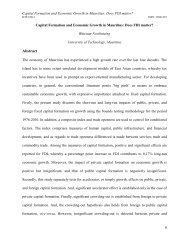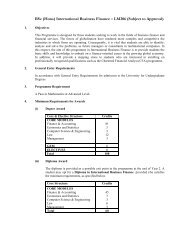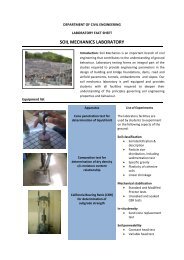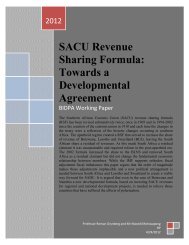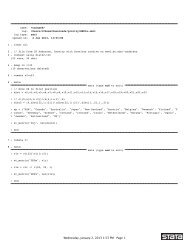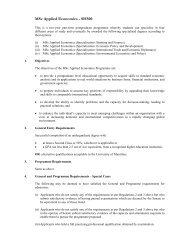A Theoretical Foundation for the Gravity Equation
A Theoretical Foundation for the Gravity Equation
A Theoretical Foundation for the Gravity Equation
You also want an ePaper? Increase the reach of your titles
YUMPU automatically turns print PDFs into web optimized ePapers that Google loves.
114 THE AMERICAN ECONOMIC REVIEW MARCH 1979<br />
<strong>the</strong> greater efficiency of <strong>the</strong> gravity equation<br />
(1) in aggregate <strong>for</strong>m in arriving at<br />
estimates of /jYj dominates,"7 and <strong>the</strong> O's<br />
can be estimated from<br />
( 12') Mijk = [(f) Y 0 ik LUijk<br />
If <strong>the</strong> bias from omitting <strong>the</strong> bracketed term<br />
is likely to be substantial, (16) can be estimated<br />
with constant weights in <strong>the</strong> bracket<br />
term equal to observed trade total expenditure<br />
shares. Non-linear least squares is required,<br />
implying some loss in efficiency.<br />
Which procedure is preferable depends on<br />
<strong>the</strong> tradeoff.<br />
Practitioners may be able to get away<br />
with restrictions less extreme than ei<strong>the</strong>r<br />
<strong>the</strong> identical transit costs or Cobb-Douglas<br />
asstumptions. Consider <strong>the</strong> CES preference<br />
case where trade taxes are <strong>the</strong> same across<br />
all countriesj <strong>for</strong> any good k of country i<br />
(often an assumption which comes close to<br />
reality, as in <strong>the</strong> EEC). Assume transport<br />
cost factors depend only on distance (not<br />
on commodity group). Under <strong>the</strong>se conditions,<br />
<strong>the</strong> Appendix shows that a gravity<br />
equation may still have some promise of<br />
providing efficiency gains which dominate<br />
bias. The CES demand functions may be<br />
estimated as above.in a second stage using<br />
<strong>the</strong> instrument 1j Yj. In principle, a trade<br />
17Disregarding bias, <strong>the</strong> procedure <strong>for</strong> solving out<br />
<strong>the</strong> parameters of <strong>the</strong> m( ) and F( ) functions are essentially<br />
<strong>the</strong> same as in Section II. The only new factor<br />
is <strong>the</strong> presence of f(dij). If we adopt <strong>the</strong> log-linear<br />
<strong>for</strong>m, (16) assures us that any constant term it possesses<br />
is cancelled out (i.e., if f (dij) = kddg'1, <strong>the</strong> kd<br />
term would not appear in <strong>the</strong> general constant term<br />
of <strong>the</strong> estimator of(16)). The constant term kd can be<br />
identified by noting that<br />
Mij Y +lNikN 1<br />
(e) M -<br />
Y4$y+MNii<br />
<strong>Equation</strong> (a) of fn. 9 becomes<br />
(a')<br />
kmk,0 kd = M[ Mi;+ Mi,n]<br />
j=l<br />
N (N+ ^ N)d<br />
N kddlA<br />
Y II+I<br />
Y+y<br />
<strong>Equation</strong>s (a'), (e), as well as (b) and (c) of fn. 9 can<br />
be solved <strong>for</strong> all constant term estimates. O<strong>the</strong>r distance<br />
functions will require o<strong>the</strong>r identifying restrictions.<br />
flow system in <strong>the</strong> gravity model style capable<br />
of dealing with tariffs and even possibly<br />
with policy-induced change in shares<br />
can be developed.<br />
V. Conclusion<br />
The gravity equation can be derived from<br />
<strong>the</strong> properties of expenditure systems. In<br />
this interpretation it is an alternative<br />
method of doing cross-section budget<br />
studies, and one with potentially important<br />
efficiency properties. Its use is at <strong>the</strong> widest<br />
limited to countries where <strong>the</strong> structure of<br />
traded-goods preference is very similar and,<br />
subsidiarily, where trade tax structures and<br />
transport cost structures are similar. In<br />
future work, it would be desirable to learn<br />
more about <strong>the</strong> tradeoff between bias and<br />
efficiency involved in <strong>the</strong> gravity equation.<br />
O<strong>the</strong>r extensions include building an intertemporal<br />
version and identifying <strong>the</strong> tradeshare<br />
function.<br />
APPENDIX:<br />
THE CES CASE<br />
The CES traded goods utility indicator is<br />
U- E d3ikMk-JP ]<br />
i<br />
k<br />
where Mijk is <strong>the</strong> quantity of good k from<br />
country i consumed in country j. Good k<br />
is a different commodity in each country<br />
due to differentiation. The elasticity of substitution<br />
is a = l/(I + p). Expenditure shares<br />
derived from such a utility function are<br />
(A(Al)<br />
I ) e 0ijk ijk -<br />
E E<br />
ikPik)_0<br />
1,(Pk)IA_ ik<br />
where Oijk is <strong>the</strong> traded-goods expenditure<br />
share of country j <strong>for</strong> good k of country i,<br />
and P,jk is <strong>the</strong> price of good k from country<br />
i landed in country j. The denominator of<br />
(Al), when raised to <strong>the</strong> power l/(I - a),<br />
gives <strong>the</strong> "true cost-of-living" index <strong>for</strong> <strong>the</strong><br />
CES function. The demand <strong>for</strong> imports is<br />
I<br />
(A2) Miik = Oijk+j Yj<br />
Derivations are standard, so omitted.<br />
Assume now that <strong>the</strong> transit cost factors<br />
ijk<br />
This content downloaded on Thu, 3 Jan 2013 15:32:06 PM<br />
All use subject to JSTOR Terms and Conditions




